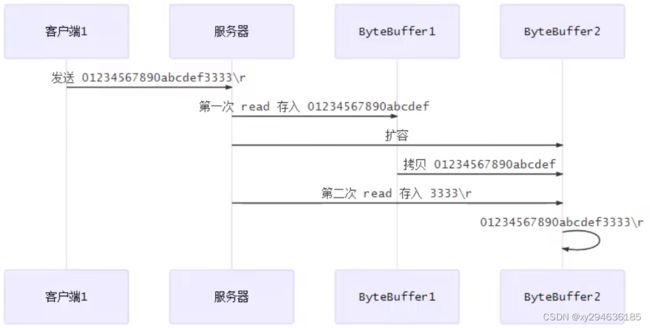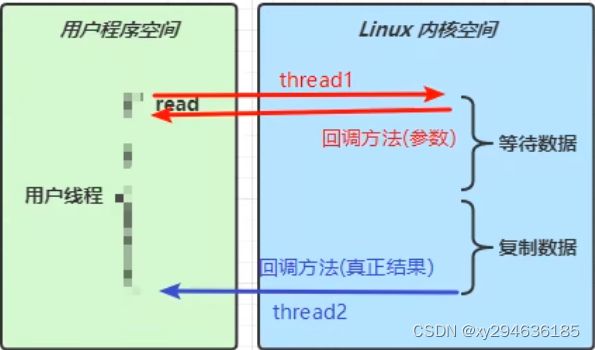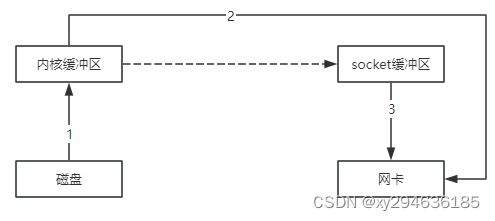Netty(一)NIO-基础
Netty
分布式根基于网络编程,Netty恰是java网络编程的王者,致力于高性能编程。
前置
适用于网络开发,服务器开发。多线程,线程池,maven。
大纲
- NIO编程(Selector,ByteBuffer和Channel)
- Netty入门:EventLoop,Channel,Future,Pipeline,Handler,ByteBuf
- Netty进阶:粘包半包,协议,序列化
- Netty调优:参数优化
- Netty源码
NIO基础
non-clocking io:非阻塞IO
1 三大组件
1.1 Channel&Buffer
Channel是读写数据的双向通道。常见通道的有File,Datagram,Socket,ServerSocket。
Buffer是用来缓冲读写数据的。常见的有Byte(Mapped,Direct,Heap),Int,Float,Double,Char,
1.2 Selector
多线程版本:早期的服务器基于多线程实现。内存占用高,线程上下文切换成本高,只适合连接少的场景。
线程池版本:阻塞模式下,线程仅能处理一个socket连接,仅适合短链接场景。
selector版本:selector作用就是配合一个线程来管理多个channel,获取channel上发生的事件,这些channel工作在非阻塞下,不会让线程吊死在一个channel上适合连接多但流量低的场景。
调用selector的select()会阻塞直到channel发生了读写就绪事件,select方法会返回这些事件交给thread来处理。
2 ByteBuffer
- 向buffer写入数据:channel.read(buffer);
- 调用filp切换读模式
- 从buffer读数据:buffer.get();
- 调用clear或compact切换写模式
- 重复1-4
2.1 ByteBuffer结构
Buffer/ByteBuffer/ByteBuf详解
ByteBuffer有以下重要属性:capacity容量,position读写指针,limit限制。
flip:position切换读取位置,limit切换为读取限制
compact:把未读完的部分向前压缩,然后切换写模式


2.2 ByteBuffer常见方法
分配空间:ByteBuffer buf = ByteBuffer.allocate(16);(堆,低效,会GC)ByteBufferDirect(16); (直接内存,高效,不会GC,分配低效)
写入数据:
* 调用channel的read方法:channel.read();
* 调用buffer自己的put方法:buf.put();
读取数据:
* 调用channel的write方法:channel.write();
* 调用buffer自己的get方法:buf.get();
* 注:get方法会将position指针向后走,想重复读可调用rewind方法将position置0或get(i);
* 标记position:mark
* 回到标记位置:reset
字符串与ByteBuffer转换:
* 直转方法:buffer.put(“hello”.getBytes());
* Charset方法:ByteBuffer buf = StandardCharsets.UTF_8.encode(“hello”);
* wrap方法:ByteBuffer buf = ByteBuffer.wrap(“hello”.getBytes());
* 回转String:StandardCharsets.UTF_8.decode(buf).toString();
2.3 组合练习
public class TestByteBufferExam {
public static void main(String[] args) {
/**
* 网络上多条数据发送客户端使用/n进行分割,但由于某种原因,被进行重新组合,例如
* Hello,world\n
* I'm aric\n
* How are you?\n
* 变成下面的两个 byteBuffer(粘包,半包)
* Hello,world\nI'm aric\nHo
* w are you?\n
* 现要求将错乱的数据恢复按\n分割数据
*/
ByteBuffer source = ByteBuffer.allocate(32);
source.put("Hello,world\nI'm aric\nHo".getBytes());
split(source);
source.put("w are you?\n".getBytes());
split(source);
}
private static void split(ByteBuffer source) {
source.flip();
for (int i = 0; i < source.limit(); i++) {
if (source.get(i) == '\n') { //找到一条完整消息
int length = i + 1 - source.position(); //消息长度
//把这条完整的消息存入新的ByteBuffer
ByteBuffer target = ByteBuffer.allocate(length);
//从source读,向target写
for (int j = 0; j < length; j++) {
byte b = source.get();
target.put(b);
}
debugAll(target);
}
}
source.compact();
}
}
3 文件编程
3.1 FileChannel
注:FileChannel只能工作在阻塞模式下。
获取
不能直接打开FIleChannel,必须通过FileInputStream,FileOutputStream或RandomAccessFile来获取FileChannel,他们都有getChannel();
- FileInputStream:此channel只能读
- FileOutputStream:此channel只能写
- RandomAccessFile:根据其读写模式决定
读取
会从channel读取数据填充ByteBuffer,返回值表示读到多少字节,-1表示达到了文件的末尾。
int readBytes = channel.read(buffer);
写入
ByteBuffer buffer = ...;
buffer.put(); //存入数据
buffer.filp(); //切换读模式
while(buffer.hasRemaining()){ //用while因为buffer无法保证一次读取channel中全部内容。
channel.write(buffer);
}
关闭
channel必须关闭。
位置
获取当前位置:long pos = hannel.position();
设置当前位置:channel.position(pos);
大小
size方法
强制写入
数据先会缓存,调用force(true)方法可将文件内容和元数据立刻写入磁盘。
3.2 两个Channel传输数据
try (FileChannel from = new FileInputStream("data.txt").getChannel();
FileChannel to = new FileOutputStream("to.txt").getChannel();
) {
//transferTo底层采用零拷贝,效率高
//from.transferTo(0, from.size(), to); 最大只能传输2G
long size = from.size();
for (long left = size; left > 0; ) { //left 表示剩余多少字节
left -= from.transferTo((size - left), left, to);
}
} catch (IOException e) {
e.printStackTrace();
}
3.3 Path
jdk7引入Path和Paths类,Path表示文件路径,Paths是工具类,用来获取path实例。
3.4 Files
检查文件是否存在
Path path = Paths.get(“data.txt”);
System.out.println(Files.ex);
拷贝文件
Files.copy(source, target);
移动文件
Files.move(source, target, StandardCopyOption.ATOMIC_MOVE);
删除文件
Files.delete(target);
3.5 遍历文件(访问者模式)
public static void main(String[] args) throws IOException {
walkFile(); //遍历文件
deleteFile(); //删除文件
String source = "I:\\BaiduNetdiskDownload";
String target = "I:\\BaiduNetdisk";
copyFile(source, target); //拷贝文件
}
private static void walkFile() throws IOException {
AtomicInteger dirCount = new AtomicInteger();
AtomicInteger fileCount = new AtomicInteger();
AtomicInteger jarCount = new AtomicInteger();
Files.walkFileTree(Paths.get("I:\\BaiduNetdiskDownload"), new SimpleFileVisitor<Path>() {
@Override
public FileVisitResult preVisitDirectory(Path dir, BasicFileAttributes attrs) throws IOException {
System.out.println(">" + dir);
dirCount.incrementAndGet();
return super.preVisitDirectory(dir, attrs);
}
@Override
public FileVisitResult visitFile(Path file, BasicFileAttributes attrs) throws IOException {
if (file.toString().endsWith(".jar")) {
System.out.println(file);
jarCount.incrementAndGet();
}
System.out.println(file);
fileCount.incrementAndGet();
return super.visitFile(file, attrs);
}
});
System.out.println(dirCount);
System.out.println(fileCount);
System.out.println(jarCount);
}
private static void deleteFile() throws IOException {
Files.walkFileTree(Paths.get("I:\\BaiduNetdisk"), new SimpleFileVisitor<Path>(){
@Override
public FileVisitResult visitFile(Path file, BasicFileAttributes attrs) throws IOException {
Files.delete(file);
return super.visitFile(file, attrs);
}
@Override
public FileVisitResult postVisitDirectory(Path dir, IOException exc) throws IOException {
Files.delete(dir);
return super.postVisitDirectory(dir, exc);
}
});
}
private static void copyFile(String source, String target) throws IOException {
Files.walk(Paths.get(source)).forEach(path -> {
try {
String targetName = path.toString().replace(source, target);
//是目录
if (Files.isDirectory(path)) {
Files.createDirectories(Paths.get(targetName))
}
//是普通文件
else if (Files.isRegularFile(path)) {
Files.copy(path, Paths.get(targetName));
}
} catch (IOException e) {
e.printStackTrace();
}
});
}
4 网络编程
4.1 阻塞&非阻塞
阻塞
- 阻塞模式下,相关方法都会导致线程暂停
- ServerSocketChannel.accept 会在没有连接建立时让线程暂停
- SocketChannel.read 会在没有数据可读时让线程暂停
- 没有数据和数据复制过程中,线程阻塞等待,不占CPU,空闲
- 单线程下,阻塞方法之间相互影响,几乎不能工作,需多线程支持
- 多线程下需考虑问题:
- 32位jvm一个线程320K,64位jvm一个线程1024K,为减少线程数,需采用线程池技术。
- 即使用线程池,多链接长时间inactive,会阻塞线程池中所有线程。
非阻塞
- 非阻塞下,相关方法都不会让线程暂停
- 在 ServerSocketChannel.accept 在没有连接建立时,会返回 null,继续运行
- SocketChannel.read 在没有数据可读时,会返回 0,但线程不必阻塞,可以去执行其它 SocketChannel 的 read 或是去执行ServerSocketChannel.accept
- 写数据时,线程只是等待数据写入 Channel 即可,无需等 Channel 通过网络把数据发送出去
- 在某个channel没有可读事件时,线程不必阻塞,可去处理其他有可读事件的channel
- 数据复制过程中,线程实际还是阻塞的(AIO改进)
多路复用
线程必须配合Selector才能完成对多个Channel可读写事件的监控,即多路复用。
- 多路复用仅针对网络IO,普通文件IO没法利用多路复用。
- 如果不用Selector的非阻塞模式,那么Channel读取到的字节很多时候都是0,而Selector保证了有可读事件才读取。
- 有可连接事件时才去连接
- 有可读事件才去读取
- 有可写事件才去写入
- Channel输入的数据一旦准备好,会触发Selector的可读事件

//nio 阻塞模式&非阻塞
public static void main(String[] args) throws IOException {
//消息缓冲区
ByteBuffer buffer = ByteBuffer.allocate(16);
//创建服务器
ServerSocketChannel ssc = ServerSocketChannel.open();
ssc.configureBlocking(false); //非阻塞模式开启,没有建立连接时,sc返回null
//绑定监听端口
ssc.bind(new InetSocketAddress(8080));
ArrayList<SocketChannel> channels = new ArrayList<>();
while (true) {
//循环监听客户端连接 accept socket用来与客户端通信
SocketChannel sc = ssc.accept(); //阻塞方法:线程停止运行,没链接时阻塞
if(sc != null){
sc.configureBlocking(false); //将socketChannel设为非阻塞模式。如果没有读到数据,read返回0
channels.add(sc);
}
for (SocketChannel channel : channels) {
channel.read(buffer); //阻塞方法:线程停止运行,没有数据时阻塞
buffer.flip();
System.out.println(buffer);
buffer.clear();
}
}
}
4.2 Selector
- 一个线程配合 selector 就可以监控多个 channel 的事件,事件发生线程才去处理。避免非阻塞模式下所做无用功
- 让这个线程能够被充分利用
- 节约了线程的数量
- 减少了线程上下文切换
4.3 处理read事件
void selectorEdition() throws IOException {
//1. 创建selector
Selector selector = Selector.open();
ServerSocketChannel ssc = ServerSocketChannel.open();
ssc.configureBlocking(false);
//2. 建立selector和channel的注册,sscKey是事件的句柄,是将来事件发生后,通过它可以知道事件和哪个channel的事件
SelectionKey sscKey = ssc.register(selector, 0, null);
//表示sscKey只关注accept事件
sscKey.interestOps(SelectionKey.OP_ACCEPT);
ssc.bind(new InetSocketAddress(8080));
while (true) {
//3. select 方法,没有事件发生,线程阻塞,有事件,线程才会恢复运行
//selector在事件未处理时,不会阻塞,事件发生后要么处理,要么取消,不能置之不理
selector.select();
//4. 处理事件,selectedKeys内部包含了所有发生的事件
Iterator<SelectionKey> iter = selector.selectedKeys().iterator(); //selector发生事件后,selectedKeys集合只有加入,不会删除
while (iter.hasNext()) {
SelectionKey key = iter.next();
//处理完key一定要移除调,不然下次处理时会报空指针异常
iter.remove();
//5. 区分事件类型
if (key.isAcceptable()) { //如果时accept
ServerSocketChannel channel = (ServerSocketChannel) key.channel();
SocketChannel sc = channel.accept();
//读取事件
sc.configureBlocking(false);
SelectionKey scKey = sc.register(selector, 0, null);
scKey.interestOps(SelectionKey.OP_READ);
} else if (key.isReadable()) {
try {
SocketChannel channel = (SocketChannel) key.channel();
ByteBuffer buffer = ByteBuffer.allocate(16);
int read = channel.read(buffer); //正常断开,read返回-1
if (read == -1) {
key.cancel();
} else {
buffer.flip();
System.out.println(buffer);
//split(buffer); //使用分隔符方式接收消息
}
} catch (IOException e) {
e.printStackTrace();
//客户端出异常情况,需手动从selectedKeys集合取消key
key.cancel();
}
}
}
}
}
绑定Channel事件
channel 必须工作在非阻塞模式
FileChannel 没有非阻塞模式,因此不能配合 selector 一起使用
绑定的事件类型可以有
- connect - 客户端连接成功时触发
- accept - 服务器端成功接受连接时触发
- read - 数据可读入时触发,有因为接收能力弱,数据暂不能读入的情况
- write - 数据可写出时触发,有因为发送能力弱,数据暂不能写出的情况
监听Channel事件
可以通过下面三种方法来监听是否有事件发生,方法的返回值代表有多少 channel 发生了事件
方法1:阻塞直到绑定事件发生-selector.select();
方法2:阻塞直到绑定事件发生,或是超时(时间单位为 ms)-selector.select(long timeout);
方法3:不会阻塞,也就是不管有没有事件,立刻返回,自己根据返回值检查是否有事件-selector.selectNow();
select 何时不阻塞
事件发生时
- 客户端发起连接请求,会触发 accept 事件
- 客户端发送数据过来,客户端正常、异常关闭时,都会触发 read 事件,另外如果发送的数据大于 buffer 缓冲区,会触发多次读取事件
- channel 可写,会触发 write 事件
- 在 linux 下 nio bug 发生时
调用 selector.wakeup()
调用 selector.close()
selector 所在线程 interrupt
事件发生后能否不处理
事件发生后,要么处理,要么取消(cancel),不能什么都不做,否则下次该事件仍会触发,这是因为 nio 底层使用的是水平触发
为何要 iter.remove()
因为 select 在事件发生后,就会将相关的 key 放入 selectedKeys 集合,但不会在处理完后从 selectedKeys 集合中移除,需要我们自己编码删除。例如
- 第一次触发了 ssckey 上的 accept 事件,没有移除 ssckey
- 第二次触发了 sckey 上的 read 事件,但这时 selectedKeys 中还有上次的 ssckey ,在处理时因为没有真正的 serverSocket 连上了,就会导致空指针异常
cancel 的作用
cancel 会取消注册在 selector 上的 channel,并从 keys 集合中删除 key 后续不会再监听事件。
处理消息的边界
- 一种思路是固定消息长度,数据包大小一样,服务器按预定长度读取,缺点是浪费带宽
- 另一种思路是按分隔符拆分,缺点是效率低
- TLV 格式,即 Type 类型、Length 长度、Value 数据,类型和长度已知的情况下,就可以方便获取消息大小,分配合适的 buffer,缺点是 buffer 需要提前分配,如果内容过大,则影响 server 吞吐量
if (key.isAcceptable()) { //如果时accept
ServerSocketChannel channel = (ServerSocketChannel) key.channel();
SocketChannel sc = channel.accept();
//读取事件
sc.configureBlocking(false);
ByteBuffer buffer = ByteBuffer.allocate(16); //attachment buffer和sc绑定
SelectionKey scKey = sc.register(selector, 0, null, buffer);
scKey.interestOps(SelectionKey.OP_READ);
} else if (key.isReadable()) {
try {
SocketChannel channel = (SocketChannel) key.channel();
ByteBuffer buffer = (ByteBuffer) key.attachment(); //从key中获取独有的ByteBuffer
int read = channel.read(buffer); //正常断开,read返回-1
if (read == -1) {
key.cancel();
} else {
//buffer.flip();
//System.out.println(buffer);
split(buffer); //使用分隔符方式接收消息
if(buffer.position() == buffer.limit()) { //扩容
ByteBuffer newBuffer = ByteBuffer.allocate(buffer.capacity() * 2);
buffer.flip();
newBuffer.put(buffer);
key.attach(newBuffer); //替换原key中的ByteBuffer
}
}
} catch (IOException e) {
e.printStackTrace();
//客户端出异常情况,需手动从selectedKeys集合取消key
key.cancel();
}
}
- ByteBuffer大小分配
- 每个channel都需要记录可能被切分的消息,因为ByteBuffer不是线程安全的,因此需要为每个channel维护一个独立的ByteBuffer
- ByteBuffer不能太大,比如一个ByteBuffer 1Mb的话,要支持百万连接就要1Tb内存,因此需要设计大小可变的ByteBuffer
一种思想是首先分配一个较小的buffer,不够再扩容,优点是消息连续容易处理,缺点是数据拷贝耗性能。
另一种思想是用多个数组组成buffer,一个数组不够,把多出来的内容写入新的数组,区别是消息存储不连续,解析复杂,优点是避免拷贝
4.4处理write事件
- 非阻塞模式下,无法保证把 buffer 中所有数据都写入 channel,因此需要追踪 write 方法的返回值(代表实际写入字节数)
- 用 selector 监听所有 channel 的可写事件,每个 channel 都需要一个 key 来跟踪 buffer,但这样又会导致占用内存过多,就有两阶段策略
- 当消息处理器第一次写入消息时,才将 channel 注册到 selector 上
- selector 检查 channel 上的可写事件,如果所有的数据写完了,就取消 channel 的注册
- 如果不取消,会每次可写均会触发 write 事件
example:https://gitee.com/xuyu294636185/netty-demo.git
write 为何要取消
只要向 channel 发送数据时,socket 缓冲可写,这个事件会频繁触发,因此应当只在 socket 缓冲区写不下时再关注可写事件,数据写完之后再取消关注
4.5多线程版
- 单线程配一个选择器,专门处理 accept 事件
- 创建 cpu 核心数的线程,每个线程配一个选择器,轮流处理 read 事件
代码:https://gitee.com/xuyu294636185/netty-demo.git
5. NIO&BIO
5.1 stream与channel
- stream不会自动缓存数据,channel会利用系统提供的发送缓冲区,接收缓存区
- stream仅支持阻塞API,channel同时支持阻塞,非阻塞API,网络channel可配合selector实现多路复用。
- 二者均为全双工,即读写可同时进行
5.2 IO模型
当调用一次channel.read或stream.read后,会切换至操作系统内核态完成真正的数据读取,而读取又分为:等待数据阶段、复制数据阶段。

阻塞IO:用户态调用内核态阻塞,等待内核态数据就绪复制完成后才能返回。期间用户和内核都阻塞
非阻塞IO:用户态调用内核态阻塞会立刻返回并循环直到有数据。用户态只有在等待数据时非阻塞,复制数据时还是阻塞。但是内核和用户切换很频繁。
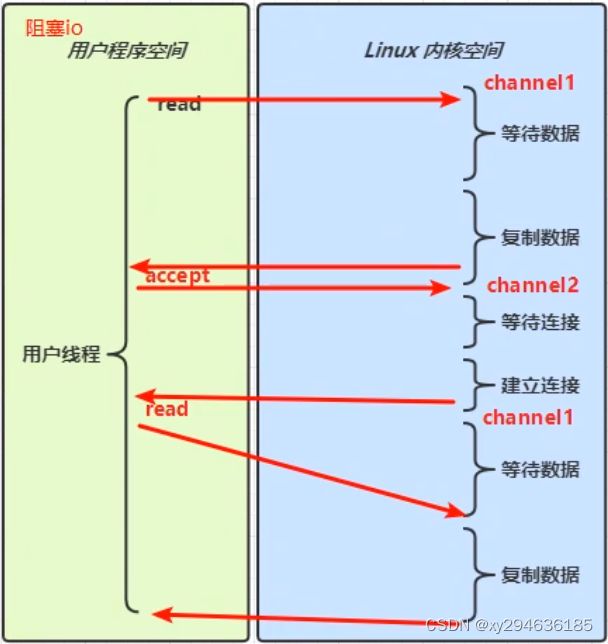
多路复用:先调用select方法,用户态调用内核阻塞,有事件才返回用户态,用户态再读取内核态阻塞等待复制数据完后才返回。期间用户和内核都阻塞。
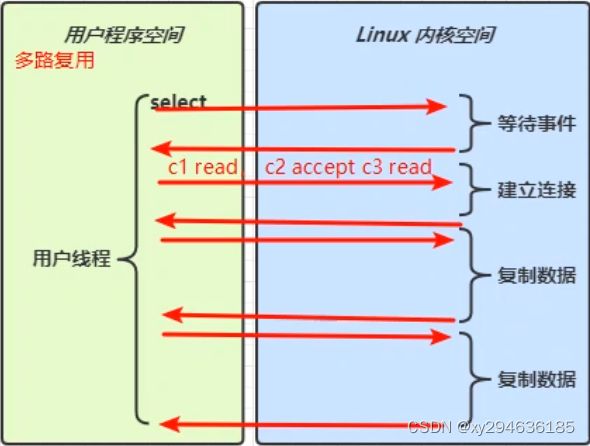
5.3 零拷贝
传统IO
传统IO:将文件先通过accessfile读入byte数组中,再通过socket输出流i写出客户端。
File f = new File("data.txt");
RandomAccessFile file = new RandomAccessFile(file, "r");
byte[] buf = new byte[(int)f.length()];
file.read(buf);
Socket socket = ...;
socket.getOutputStream().write(buf);
- java本身不具备IO读写能力,read调用从用户态切换到内核态,操作kernel系统,将数据读到内核缓冲区,期间用户线程阻塞,系统使用DMA实现文件读,期间也不会使用CPU
- 从内核态切回用户态,将数据从内核缓冲区读入用户缓冲区,期间cpu参与拷贝,无法利用DMA
- 调用write方法,将数据从用户缓冲区写入socket缓冲区,cpu参与拷贝
- 接下来要向网卡写入数据,这项能力java又不具备,因此又得到从用户态切换至内核态,调用操作系统的写能力,使用DMA将socket缓冲区的数据写入网卡,不会使用cpu。
可以看到中间环节较多,java的IO实际不是物理设备级别的读写,而是缓存的复制,底层的真正读写是操作系统来完成的。
- 用户态与内核态的切换发生了3次,这个操作比较重量级。
- 数据拷贝了4次。
NIO优化
通过DirectByteBuf
- ByteBuffer.allocate(10) HeapByteBuffer 使用的还是java内存
- ByteBuffer,allocateDirect(10) DirectByteBuffer 使用的是操作系统内存
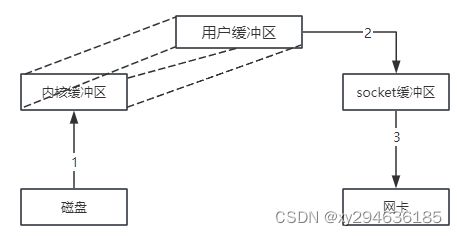
不同:java使用DurectByteBuf将堆外内存映射到jvm内存中来直接访问使用 - 这块内存不受jvm垃圾回收的影响,因此内存地址固定,有助于IO读写
- java中的DirectByteBuf对象仅维护了此内存的虚引用,内存回收分成两步
- DirectByteBuf对象被垃圾回收,将虚引用加入引用队列
- 通过专门线程访问引用队列,根据虚引用释放堆外内存
- 减少一次数据拷贝,用户态与内核态的切换次数没有减少
linux2.1进一步优化
底层词用linux提供的sendFile方法,java中对应两个channel调用transferTo/transferFrom方法拷贝数据。
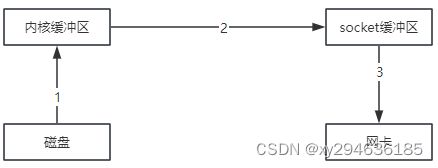
- java调用transferTo方法,从java程序的用户态切换至内核态,使用DMA将数据读入内核缓冲区,不会使用cpu。
- 将数据从内核缓冲区传输到socket缓冲区,cpu会参与拷贝
- 最后使用DMA将socket缓冲区的数据写入网卡,不会使用cpu
- 只发生了一次用户和内核的切换
- 数据拷贝了三次
linux2.4进一步优化
- java调用transferTo方法后,要从java程序的用户态切换至内核态,使用DMA将数据读入内核缓冲区,不会使用cpu
- 只会将一些offset和length信息拷入socket缓冲区,几乎无消耗
- 使用DMA将内核缓冲区的数据写入网卡,不会使用cpu
- 只发生一次用户和内核切换
- 数据拷贝2次。所谓零拷贝并不是无拷贝,而是在不会拷贝重复数据到jvm内存中,优点:
- 更少用户-内核切换
- 不利用cpu计算,减少cpu缓存伪共享
- 零拷贝适合小文件传输
5.4 AIO
AIO用来解决数据复制阶段的阻塞问题。
- 同步:读写中线程等待,闲置
- 异步:读写中线程不等待,可由系统通过回调方式由其他线程获取结果
异步模型需底层系统kernel支持
- Windows通过IOCP实现真正的异步IO
- Linux系统异步IO在2.6版本中引入,但其底层还是多路复用模拟异步IO,性能没优势

